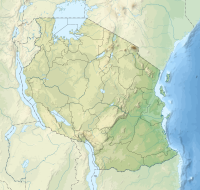Liwale (District)
| Liwale District
|
||
|---|---|---|
| Basic data | ||
| Country | Tanzania | |
| region | Lindi | |
| surface | 38,380 km² | |
| Residents | 91,380 (2012) | |
| density | 2.4 inhabitants per km² | |
| ISO 3166-2 | TZ-12 | |
Coordinates: 9 ° 14 ′ S , 36 ° 37 ′ E
Liwale is a district in the Tanzanian region of Lindi with the administrative headquarters in Liwale . The district borders the Pwani region to the north, the Kilwa district to the east, the Nachingwea district and the Ruvuma region to the south, and the Morogoro region to the west .
geographyThe district has an area of 38,380 square kilometers and 91,380 inhabitants (as of 2012) and is very sparsely populated with 2.4 inhabitants per square kilometer. Two thirds of the total area is forest. The majority is 25,587 square kilometers in the Selous Game Reserve , which takes up the entire northern and western part of the district. The Nyera-Kipele forest reserve accounts for around a thousand square kilometers. One third is living space and agricultural area, or buffer zone to the game reserve. |
 |
history
Liwale District was established in 1975. Before that he was part of the Nachingwea District.
Administrative division
The district is divided into 20 parishes (wards):
- Barikwa
- Kiangara
- Kibutuka
- Kichonda
- Kimambi
- Likongowele
- Lilombe
- Liwale 'B'
- Liwale Mjini
- Makata
- Mangirirkiti
- Mbaya
- Mihumo
- Mirui
- Mkutano
- Mlembwe
- Mpigamiti
- Nangando
- Nangano
- Ngongowele
populationThe population of Liwale increased from 52,240 in 1988 to 75,128 in 2002 and to 91,380 in 2012. This means that the annual growth rate has decreased from 2.6 percent to 2.0 percent. If this growth continues, the number of inhabitants will double in 35 years. Of those over five, 57 percent spoke Swahili, six percent English and Swahili, and 37 percent were illiterate (as of 2012). Facilities and services
|
 |
Economy and InfrastructureThe most important source of income for the population in the district is agriculture, followed by forestry. Livestock husbandry only comes fourth after activities outside of agriculture.
|
 |
Attractions
- Selous Game Reserve: The Selous Game Reserve accounts for more than half the area of the district. This 50,000 square kilometer reserve was declared a UNESCO World Heritage Site in 1982 and is known for its bird and mammal diversity. It is home to one of the largest buffalo populations in Africa.
Web links
Individual evidence
- ↑ a b c Historia | Liwale District Council. Retrieved November 22, 2019 (Swahili).
- ^ Tanzania Regional Profiles, 08 Lindi Regional Profiles. (pdf) The United Republic of Tanzania, 2016, p. 15 , accessed on November 20, 2019 .
- ^ Liwale (District, Tanzania) - Population Statistics, Charts, Map and Location. Retrieved November 22, 2019 .
- ↑ a b Home | Liwale District Council. Retrieved November 22, 2019 .
- ^ Tanzania Regional Profiles, 08 Lindi Regional Profiles. (pdf) The United Republic of Tanzania, 2016, pp. 15, 70 , accessed on November 20, 2019 .
- ↑ Elimu Sekondari | Liwale District Council. Retrieved November 22, 2019 (Swahili).
- ↑ National Sample Census of Agriculture 2002/2003, Lindi Region. (pdf) December 2007, p. 10 , accessed on December 1, 2019 .
- ↑ National Sample Census of Agriculture 2002/2003, Lindi Region. (pdf) December 2007, pp. 98–99 , accessed on December 1, 2019 .
- ^ Tanzania Regional Profiles, 08 Lindi Regional Profiles. (pdf) The United Republic of Tanzania, 2016, p. 130 , accessed on November 20, 2019 .
- ^ The Management of Wildlife Resources in Protected Areas: a Case Study of South-Eastern Sector of Selous Game Reserve Ecosystem. (pdf) IOSR Journal of Environmental Science, Toxicology and Food Technology, December 2016, p. 13 , accessed on December 1, 2019 .
- ↑ Tourist Attractions in Selous Game Reserve, Things To See. In: Selous Game Reserve. January 17, 2014, Retrieved December 1, 2019 (American English).
